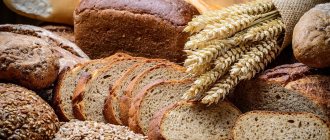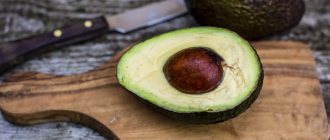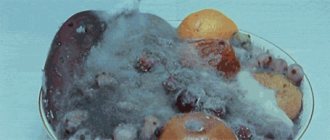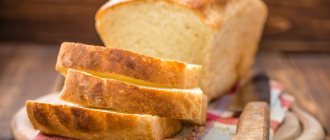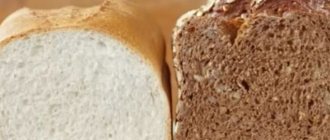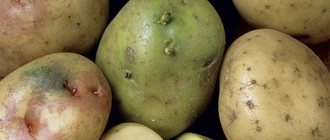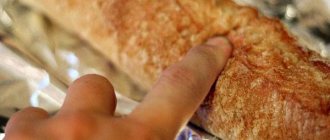Your questions:
- Where does mold come from?
- How many days does it take for mold to germinate?
- At what point does bread become unhealthy?
- If a person eats moldy bread, will there be any consequences for the body?
- Can mold occur on both wheat and rye bread?
- Mold can be black, white, green... Which is the most dangerous?
- Is it true that sliced bread is the first to go moldy?
- What conditions are needed for mold to grow on bread?
- How to properly store bread at home to prevent it from becoming moldy?
- Why does bread in a plastic bag mold faster than bread in paper or under a towel?
I accidentally ate a piece of bread with mold during pregnancy: should I panic?
A pregnant woman is responsible not only for herself, but also for her unborn baby. Therefore, she must select her food products more scrupulously, and certainly exclude not only moldy bread, but even that which simply smells dubious. But if suddenly she accidentally ate a small piece of contaminated product, nothing bad will happen .
To calm down , you can take a number of measures by drinking the same activated carbon and water acidified with lemon juice . Signs of toxicosis during pregnancy are not the action of fungal spores, but just one of the features of pregnancy.”
Nausea can be triggered by the psychological awareness of fungal penetration or the smell of mold. To calm down, you can resort to a folk remedy - drink tea with mint and honey , or suck a slice of lemon.
Where does mold come from?
The air on the street, at home and in the office, in the air of any industrial premises (except for those where special preparation and sterilization of the air is carried out) contains a wide variety of microorganisms, including mold spores. Bread molding is a process that begins when mold spores enter the surface of the product from the air. Once in favorable conditions, the dispute begins to germinate.
Once the mold spores have sprouted, the product is no longer suitable for consumption.
2. How many days does it take for mold to germinate?
The rate at which visible signs of mold appear depends on many factors: bread storage conditions (humidity, temperature, presence and type of packaging), the type of bakery products and the method of their preparation, the sanitary state of production, as well as the type of mold and its physiological characteristics.
Olesya Savkina
Leading Researcher at FGANU NIIHP, Ph.D.
– Our model experiments show that when bakery products are forcibly infected with mold, the shortest period of time before signs of mold appear is:
- 24 hours – for wheat bakery products prepared in an accelerated way, without dough and sourdough;
- 36 hours - for wheat products prepared using long-term technology - for example, using sourdough or sourdough;
- 40 hours – for rye and rye-wheat bread.
Wheat and rye bread do not become moldy within 24 hours after baking.
3. At what point does bread become unhealthy?
To understand at what point bread becomes dangerous, let's try to understand the mechanism of formation of this type of microbial spoilage. If the bread is infected with mold spores, the germination of the invisible mycelium of the fungus inside the bread and the formation of a “fluffy” colored colony on the surface visible to the eye occurs simultaneously. Until visible signs appear, that is, until a small, 1–1.5 mm in diameter, most often first white, slightly fluffy “dot”—a colony—appears on the surface of the bread, the bread is safe.
If mold is not visible, you need to smell the bread.
A small, nascent mold colony is very difficult to notice. Therefore, you also need to focus on taste and smell. If the product has a slight rancid or moldy odor, this indicates that the process of microbial deterioration has already begun. And it is better not to eat such bread.
4. If a person eats moldy bread, will there be any consequences for the body?
A moldy product is dangerous because mold fungi produce substances that can have an acute toxic or carcinogenic effect. Evidence suggests that moldy foods can pose a serious threat to a person's weakened immune system. They can cause diseases such as aspergillosis, bronchial asthma, as well as the development of cross-allergy to a number of products.
Simply removing the visible part of the mold colony from the surface of the bread is not enough.
Under a microscope, you can see that the mold consists of long, thin, intertwined threads (mycelium) that run throughout the product. They can produce substances hazardous to human health.
What to do if you bought a low-quality product and got food poisoning, read HERE
.
What can be done with moldy bread - where to put it
What can you do with moldy bread? It turns out it is possible, but it all depends on the degree of damage. There is a recipe for making crackers, but in this case it is important that the pieces are not heavily affected by spores.
Then cut the crust about a centimeter thick along the entire perimeter of the loaf or loaf and cut into small pieces. Next, heat the frying pan, add butter or sunflower oil and fry the small prepared pieces. The cooking time for such crackers depends on the degree of spore damage.
It is important to remember that this procedure is contraindicated with a whole loaf; you must definitely cut it into small pieces. Bread with pronounced gray or green spots of mold should not be treated in this way.
Severely damaged loaves in villages are given to domestic animals, but this again depends on the degree of damage. Severely moldy food should not be given to living creatures.
Can mold occur on both wheat and rye bread?
Any baked goods, especially when stored packaged in plastic film, are an ideal place for mold to develop. It affects products made from both wheat and rye flour.
An exception is products with low humidity: dryers, crackers, straws, crispbread, bread sticks. All of them are less susceptible to mold due to low humidity, but if stored improperly in a damp room and if the integrity of the packaging is damaged, mold may develop on these products due to dampness.
If the bread goes moldy quickly
The cause of moldy bread is improper storage. The reason could be this:
- air temperature 25-30 degrees Celsius;
- in the room where the bread is stored, the humidity is above 70 percent. Moreover, the “disease” can also begin in the store where you bought the bread;
- incorrect manufacturing technology: increased moisture content in the product or dense packing during transportation;
- infection with fungal spores through dirty air, vehicles, dirty hands and clothes of people;
- if mold has grown from the inside, then the problem is in the raw materials: for example, flour or other ingredients were contaminated.
How to grow mushrooms in the country: your own oyster mushrooms all summer long.
Mold can be black, white, green... Which is the most dangerous?
Bread affected by mold is covered with a fluffy coating of various colors: white, gray, green, yellow, bluish, black. Most often, green, inky (blue-green) and black mold develop on bread.
The most poisonous are yellow mold (Aspergillus flavus) and black rot (Aspergillus fumigatus).
- Yellow mold
produces a powerful mycotoxin, aflatoxin. It can cause damage to the body, in addition, the fungus itself, when entering the body, causes severe damage to the lungs and can even lead to death. - Black rot
produces the alkaloid fumigoclavine, which can cause severe intoxication, has hemolytic and antigenic effects and pronounced allergenic properties, and causes aspergillosis.
“However, in addition to these molds,” notes Olesya Savkina
, “several dozen more types of molds form mycotoxins and substances toxic to humans.
Of course, there are also safe types of mold that people have learned to use for food production, for example, for gourmet cheeses - Dorblu, Brie, Camembert. Such “cultured” mold is considered safe, but allergic reactions to the microbial protein are possible in people with a predisposition.
Any mold is unacceptable in baked goods.
Buy quality bread
The reasons why bread gets moldy are quite simple. Mold on bread forms:
- improper storage of bread. If the finished product is stored in a humid and warm room, these are the best conditions for the growth of fungus;
- violation of sanitary standards and temperature conditions. If the bread is baked incorrectly, you get mold.
- poor quality preparation. Move away from the traditional recipe to minimize costs - get mold on the bread. If you used low-quality products or any substitutes, the result is the same. Low-quality bread becomes moldy much more often and faster than bread baked according to the correct recipe.
What conditions are needed for mold to grow on bread?
Bread comes out of the oven sterile, but during transportation and storage, the surface of the bread can become contaminated with fungal spores. As mentioned above, mold spores are ubiquitous in the air. They are activated and germinate as soon as they find conditions favorable to them - a moist environment in which nutrients are present.
Humidity in the kitchen is one of the causes of mold.
9. How to properly store bread at home to prevent it from becoming moldy?
At home, bread is usually stored in the kitchen, where air humidity can fluctuate greatly. It depends on the ventilation system, the area of the kitchen and the outflow of vapors above the stove. That's why:
- Bread is best stored in a dry, dark place, away from sources of dampness and heat. For example, in a bread box, at a temperature of plus 20–25 ° C and air humidity not higher than 70%, away from sources of strong heating or cooling.
- Make sure that the bread is not near surfaces where condensation forms. It is not recommended to place the bread bin on a window or in the stove area, where temperature and humidity fluctuations are greatest.
- If bread is stored in plastic packaging, make sure it is not exposed to the sun. Under direct sunlight, condensation begins to form inside the package, and this is favorable for the development of mold.
For information
When cooking on the stove with insufficient ventilation, the air humidity in the kitchen may exceed 70%. The exact humidity in the room is determined by a special device - a hygrometer.
10. Why does bread in a plastic bag grow mold faster than in paper or under a towel?
If you store bread in a plastic bag, and even tightly closed, there is nowhere for the moisture to evaporate. And inside the hermetically sealed polymer packaging, fairly “comfortable” conditions are created for the development of mold. Bread in paper packaging or without packaging molds more slowly, but stale faster.
Bread in the bread bin is moldy - what to do?
In Russia, bread is the main and important component on the tables. A clear understanding is passed on from generation to generation that it must be protected. Thrifty housewives store it in special containers made of plastic, wood or metal. According to experts, in terms of quality, a wooden bread box is the best, but after washing, such a product must be thoroughly dried.
However, there is a way to care that does not require washing. To do this, take a piece of cotton wool, soak it in alcohol, light it and move it inside the container or place it on a metal plate and let it burn out. This method of firing helps to destroy fungi and bacteria. Metal and plastic bread bins do not require unnecessary difficulties in care.
Bread in bread bins can spoil for the following reasons:
- improper handling of containers;
- using low-quality flour when baking.
In order to prevent the appearance of mold, you need to use the following recommendations:
- Wrap the loaf in a linen or canvas towel and put it in a saucepan, also place 2 - 3 apples, peeled potatoes, a lump of sugar, a pinch of salt there, one thing will be enough;
- Pour salt into the bottom of the container for storing flour products, which should be changed at least once a week.
High-quality bread bins are considered to be wooden products made from juniper, birch or larch. The wood of these species has bactericidal properties.
Bonus for readers: we answer a subscriber’s question about lavash
“Good afternoon, I bought lavash yesterday, but this morning it became moldy and I had to throw it away. But if mold grows for several days, does that mean that if I had eaten it yesterday, I would have eaten pita bread that was already affected by fungi?”
– If yesterday there was no mold, no visible signs, no changes in smell or taste, then at that time the product was safe for consumption. If there was even a speck of mold on the lavash that you might not have noticed, alas, the lavash is already in the risk category, says Olesya Savkina
. – Our long-term research shows that, on average, visible mold colonies appear on the surface of baked goods within 3–7 days. In conditions favorable for mold, this period can be reduced to 1–2 days. Lavash is one of the most susceptible products to mold. But since it takes at least 24 hours for mold to develop from spores on the surface of pita bread, we can say that the product was safe the day before. Once the mold has sprouted, the product becomes unfit for consumption.
Take the TEST
and find out
what kind of furfural you are
. No joke, it helps you understand how safe what you eat is.
Thank you for reading this text to the end. Follow the news, subscribe
mail.
When quoting this material, active link to the source
required.
What to do if you do eat it
Realizing that moldy bread has entered the body, some begin to panic, fearing serious consequences. And sometimes they don’t even know what to do if they eat moldy bread. Although in case of such an oversight a person can provide first aid to himself .
- It is enough to drink an absorbent agent - activated carbon , which is taken at the rate of 1 tablet per 10 kg of body weight.
- The drug “Enterosgel” will help to establish the intestinal microflora . The attached instructions will tell you how to use it.
- You can rinse the stomach with a weak solution of manganese, but you will have to drink at least 1 liter of liquid to provoke vomiting.
- For those who can tolerate soda, you can try taking a solution (1-2 tsp per glass of water).
- People with allergic reactions are recommended to take an antihistamine (Suprastin, Tavegil, etc.).
You should refuse to eat for several hours, while drinking a large amount of water acidified with lemon juice.
At what point does bread become unhealthy?
If the bread is infected with mold spores, the germination of the invisible mycelium of the fungus inside the bread and the formation of a “fluffy” colored colony of fungi on the surface visible to the eye occurs simultaneously. Until visible signs appear, that is, until a small, 1-1.5 mm in diameter, most often first white, slightly fluffy “dot” appears on the surface of the bread, the bread is safe.
If mold is not visible, you should smell the bread. It is very difficult to notice just a nascent mold colony. Therefore, you also need to focus on taste and smell. If the product has a slight rancid or moldy odor, this indicates that the process of microbial deterioration has already begun. It is better not to eat such bread.
First aid for mold poisoning
If symptoms of mold poisoning become obvious and you have already called an ambulance, provide first aid.
First of all, cleanse the patient's body of toxins. Rinse your stomach. Pour at least a liter of water into the patient so that he vomits. After this, give a cleansing enema with water at room temperature. If mold gets into the human body, take sorbents. The most famous: Smecta, Atoxil, Enterosgel. Before medical intervention, give the patient plenty to drink. Sweet tea is especially good in this situation. If he is rejected, let him drink ordinary boiled water at room temperature. This is necessary in order to prevent intoxication of the body. Anyone can provide first aid for bread mold poisoning. The main thing is not to panic, but to remember what can be done to help the patient get rid of the symptoms of severe intoxication.
We advise you to read: “What to do if you are poisoned by mold: first aid, possible consequences.”
How many days does it take for mold to germinate?
The rate at which visible signs of mold appear depends on many factors: bread storage conditions (humidity, temperature, presence and type of packaging), the type of bakery products and the method of their preparation, the sanitary state of production, as well as the type of mold and its physiological characteristics.
Olesya Aleksandrovna Savkina, leading researcher at the Research Institute of the Bakery Industry (FGANU NIIHP), spoke about the results of model experiments on forced contamination of bakery products with mold. The shortest period of time before signs of mold appear is:
- 24 hours - for wheat bakery products prepared in an accelerated way, without dough and sourdough;
- 36 hours - for wheat products prepared using long-term technology, for example, using sourdough or sourdough;
- 40 hours - for rye and rye-wheat bread.
So, wheat and rye bread cannot become moldy within 24 hours after baking.
Tips and how to choose a quality product
Before purchasing store-bought bread, you should carefully read the information about the composition . If there are dyes, preservatives, flavor enhancers, leavening agents, then it is better to give preference to another loaf. Signs of such enhancers are high looseness of the pulp - the bread begins to crumble heavily, remaining hollow inside.
If the bread is sold without packaging with the composition, then you need to choose according to external characteristics:
- A high-quality product always has an even texture.
- When pressed, it easily returns to its original position.
- If there are white streaks, this indicates that fresh dough has been mixed with old dough.
It is better to buy in certified stores, from official manufacturers. Proper storage is very important - the place should be cool and completely dry. Bread bins, especially wooden ones, are not the best place for storage.
